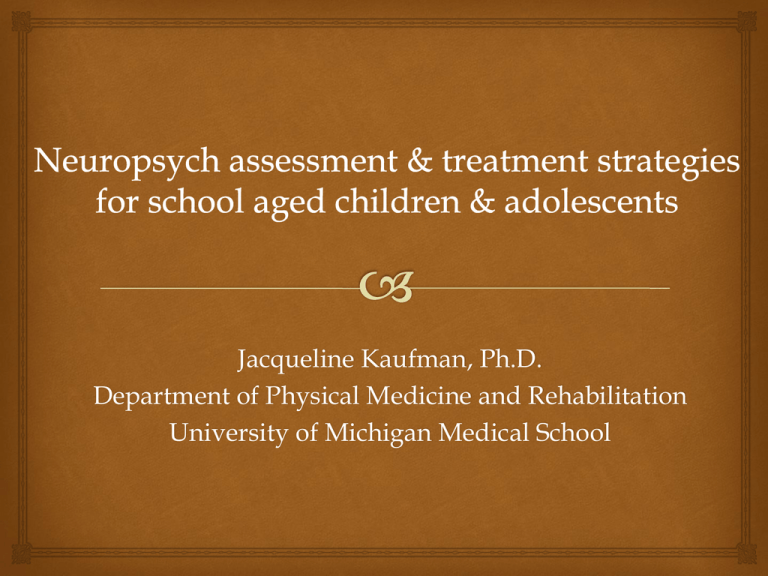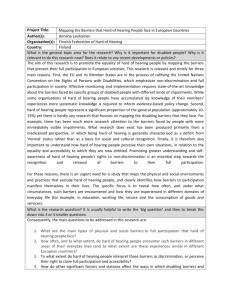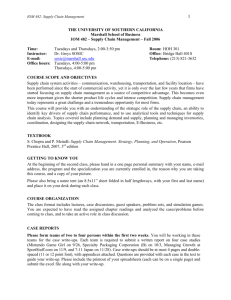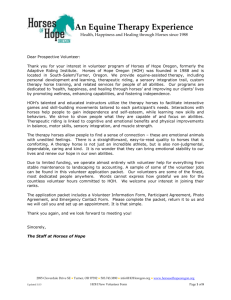School psychologists - Michigan Speech-Language
advertisement

Jacqueline Kaufman, Ph.D. Department of Physical Medicine and Rehabilitation University of Michigan Medical School What I hope you get out of this A clear picture of the processes of neuropsychological and psychoeducational testing Common pitfalls and barriers to fair and valid testing for children with speech or sensory deficits How to be critical evaluators of test results both internally and from outside sources of reports How to create access and reduce barriers for more severely impaired children Practical matters related to educational planning for children with speech/hearing challenges. Psychologists A psychologist typically has a masters or doctoral degree (PhD or PsyD). A psychologist has studied how the brain works (to varying degrees) and how this affects the way a person thinks, acts or feels. School psychologists help children and youth succeed academically, socially, behaviorally, and emotionally. They collaborate with educators, parents, and other professionals to create safe, healthy, and supportive learning environments. What does a school psychologist do? Provide counseling, instruction, and mentoring for those struggling with social, emotional, and behavioral problems Increase achievement by assessing barriers to learning and determining the best instructional strategies to improve learning. May involve identifying and addressing learning and behavior problems that interfere with school success Evaluate eligibility for special education services (within a multidisciplinary team) Support effective individualized instruction Create positive classroom environments What is a neuropsychologist? A neuropsychologist is typically a psychologist who has additional training and experience in understanding brain-behavior relationships including functional neuroanatomy, neurophysiology and medical conditions affecting the brain and/or development. A neuropsychologist usually works with psychiatrists, neurologists, neurosurgeons, physiatrists and other medical specialists as a team to coordinate a patient’s care. In the academic setting they are frequently researchers too. Neuropsychology testing is a way to “look at” the brain Studies the brain by evaluating behavior and cognition as the output. Behavior measured in multiple ways with very comprehensive evaluation (e.g. multiple tests along multiple domains, surveys, direct observation, etc.). NP evaluations must evaluate function using a multidimensional approach. Also must consider factors such as age, gender, previous illness, psychological status, etc. in evaluating brain function. 5y/o with trapped right lateral ventricle w/severe hydrocephalus, s/p fenestration. Average to high average IQ, no deficits in neuropsych or behavioral functioning. Measuring Behavior Intellect (IQ) Attention Executive functions Memory Verbal functions Visuoperceptual, visuospatial and visuoconstructive skills and abilities Academics Motoric functions Psychological/behavioral Why have neuropsych testing? School psychologists will ideally conduct thorough psychoeducational assessments looking at intellect and learning disability concerns. The focus of a psychoeducational evaluation is qualification for special education, NOT identification of disability. Although some have added training, school psychologists are traditionally not trained extensively in medical psychology and may not know the details of the broader subset of disabilities. For children with various medical conditions and/or complex developmental histories, basic IQ and academic testing often misses the crux of the child’s needs or worse, mislead those parties making treatment and placement recommendations*. *The population of children who are deaf/hoh are at particular risk for both of these concerns. Why have neuropsych testing? Neuropsychologists, particularly in a medical center often have specific expertise in complex medical conditions. Many conditions have expected profiles. Some conditions are great imitators; need experience with these differentials (e.g. ADHD vs. sleep apnea, anxiety, low iron) Testing in the school setting rarely covers topics such as attention, memory, and executive functioning. School based testing often relies on hard ‘cutoffs’ rather than multi-domain profile based diagnostics and decision making; (domain score variability, more impaired children may benefit from review of raw instead of standard scores, fxnl performance, etc.) What are some less certain things with testing? Although we can often get quick/dirty measures of intellect and academics with children who have signficant hearing/speech concerns, this can be complicated. There are often suggestions and/or recommendations based on cognitive findings that must be coordinated with suggestions from audiology and SLP. Is sign/spoken language/total communication/other recommended? What is the prognosis for improvements in language? In learning? In cognition? Which class setting is best for this child? HI-self contained? General education? Partial mainstreaming? Other? An ideal neuropsychologist working with children who are D/HOH will recognize that these suggestions cannot happen in a vacuum; a holistic approach with good communication is key! What does the testing look like? Intelligence Measures 1) How are a seatbelt and a helmet alike? 2) What is a bird? 3) Why do we put on shoes before leaving the house? A B ? C D Modifications to testing for children who are D/HOH When possible, at least a brief nonverbal measure of intellect is administered (e.g. Leiter, C-TONI) Risk for biases of exposure to language, even though nonverbal test Doesn’t test language skills (and school involves language!) Sign language interpreter (how do we ask to identify shapes?) Modification of instructions to include demonstration Standard administration followed by testing of limits Consideration of using raw scores instead of standard scores (accounting that tests not developed for D/HOH) Using testing as baseline and monitoring rather than being slave to standard scores Teaching of tests – teachable? Able to learn through example? Pitfalls for inexperienced school psychologists and neuropsychologists May observe oral communicator and assume no need for sign interpreter. Alternatively, may assume allowing child to read instructions is sufficient accommodation (it’s not ). Assume that because person can lip-read sufficiently in conversation that oral based testing is valid. May believe if person adequate with oral skills then ok to test orally even though primary language is sign. Using an interpreter for signers is important, though inexperienced school/neuropsychologists may not recognize that syntax and grammar are different. Many signs ‘give away’ the answer (e.g. “show me your nose” or “which is the square?”); may not recognize these limitations of traditional testing. Those with NVLD may test as cognitively impaired, and those with language disorders may be overlooked if only using nonverbal measures of ability. Factors for consideration in neuropsych testing (Hill-Briggs et al., 2007) Age at onset: was it early or late onset? Is it static, fluctuating or progressive? Cause: genetic, acquired (high dose antibiotics), syndrome, illness, unknown? This impacts how the disability looks and how tests are interpreted Severity: mild/mod/sev/prof. Determines which tests we use, response format. Aiding: HA, CI, other? When started, frequency of use, benefit? Determines modality/format for testing. Primary communication mode: oral/ASL/total/MSE/cued? Influences tests administered and may influence familiarity with cultural exposure assumed in some tests. School setting: mainstream, dayschool, residential, HI, gen-ed? Cultural information and exposure. Common neuropsychological observations and risks Mean nonverbal IQ for kids who are D/HOH w/o comorbid conditions avg range; with one additional condition - low avg The same as hearing, IQ performance is in part a function of access to education, and deaf children without educational access will further have lower IQ. See also in cases of neglect. Native signers (deaf and hearing) appear stronger at visual rotation skills than non-signers. Serial STM span skills lag more frequently in children with HI; may be related to rehearsal strategies. Increased risk for sequencing problems (motor, visual-spatial, verbal); could affect reading independent of language. Reading Attainment Median reading level of deaf high school students (ages 1721) is grade 4 (half above/half below this). Predictors of success with reading include: Above average nonverbal IQ Educated/professional parents Early involvement with special education services (at or before preschool!) Stronger spoken OR sign language skills; factors that promote language comprehension aid in reading acquisition. Remember – individuals who are D/HOH can also have unrelated learning disabilities such as dyslexia! What’s family history? Don’t get caught up in the D/HOH only. Emerging literacy with CI (Nittrouer et al., 2012) Nittrouer and colleagues (2012) studied a group (n=27) of children with CI at the end of their kindergarten year to evaluate emerging literacy skills. Specific skills examined included phonological awareness, oral language skills, and early executive functioning skills. Found that children with CI performed approximately 1 SD or more below TD kids on all measures except reading fluency, speeded naming, and syllable counting. Age of first implant was a significant predictor of success as was some exposure to bimodal stimulation. Even for children who received early ID and treatment with implant there was greater risk for literacy delays. Requirements for optimal literacy? Phonological processing – what is the correspondence between the letter on the page and the sound it makes? Appears that kids with CI have an edge over their non-implanted d/hoh peers but not equal to hearing peers. Understanding of complex language patterns (e.g. figurative language, complicated syntax, inference drawing in language, grammar) Spelling skills ideally are strong. Children who have d/hoh generally have weaker spelling. Stronger vocabulary skills are important for good literacy skills. Prelingual deafness tends to be associated with poorer weaker vocabulary skills. Literacy in CI users There appear to be long term benefits for early CI users on the development of literacy skills. Earlier implantation is associated with better literacy outcomes. Stronger visual-perceptual reasoning skills appear to be good predictors of literacy development in CI users. We see related issues in hearing peers; children with visualperceptual delays are later adopters of reading due to the early visual-perceptual hump of learning letter sounds. Importantly, for any child with hearing loss, among the chief predictors of reading acquisition is the presence of a language (sign or spoken). (Unfortunate) trends from the field School diagnoses child as cognitively impaired because does poorly on standard IQ testing – want to put child in CI class. School testing puts everything on hearing and fails to explore other explanations (e.g. ADHD, dyslexia, behaviour, etc.) Child isn’t given enough time after aiding or with services to “prove” themselves before tracked out of general education. Child is only D/HOH child in area – limited socializing is not viewed as component of school services. Child may even look autistic to some due to limited social opportunities. CODP? What did their educational opportunities look like? Say teachers don’t consistently communicate w/them because tough. Suspicious because of own experience in school. Should I request a neuropsychology evaluation for a student? If you are worried about a student – yes – try to arrange for them to be evaluated by a provider who is familiar with children who are D/HOH. If not possible, speak extensively with the school psychologist. Will any neuropsychologist be a safe bet? No – The provider should be aware of the pitfalls, familiar with differences between sign and spoken language and have a plan. Sometimes no experienced or reasonably knowledgeable provider is available ‘in-network’ - consider an appeal to the insurance for experienced provider. Red flags for referral A child is not making expected progress with language (spoken or manual) in spite of being adequately aided. A child is not keeping up with peers at school, with a critical eye to monitoring literacy skill building. Social skills are not developing appropriately or the child appears “odd” interpersonally, has an unusual appearance, other. Testing through the school does not seem on the face of it to match observed functional skills (e.g. either tested as more skilled than appears true or tested too low). Attention, memory or executive function difficulties are evident, particularly if there is another medical problem or prior medical problem. Red flags for referral The family would benefit from understanding strengths and weaknesses in order to advocate for the child. If a child has a complex genetic condition or associated craniofacial anomalies your threshold may be reduced for referral. Consider a child with conductive hearing loss related to complex craniofacial differences. While the HL itself carries certain risks with language development, if the craniofacial differences include isolated cleft palate the language risks elevate further. Low threshold for referral of these kids. KEY: Don’t wait until these kids are failing or so far behind that catching up is unattainable. Early testing and careful monitoring are best. Comorbid Impairments Speech and hearing impairments are commonly observed in association with conditions that carry multiple types of disability, particularly more severe disabilities. For children with multiple or complex disabilities, flexibility in assessment and care to identify strengths/weaknesses becomes more important. How do we communicate ability and knowledge with individuals who have speech/language and hearing deficits that are more severe? Neuropsych testing is inaccessible Though designed for the purpose of identifying strengths/weaknesses in clinical populations, neuropsych testing is largely inaccessible to those with the greatest impairments How do you take a complex concept conveyed in a neuropsychological test and break it down into a digestible format for those who require AAC support? Do the tests measure the same thing when they have been modified to this degree? The case of processing speed Simply put, PS is the rate at which we are able complete mental problem solving tasks. PS may be very slow but associated with accurate responding. PS measures are typically designed to be extremely easy conceptually – focus on time of completion with accurate responding. Typical PS task KEY 1 Fill in corresponding shape as indicated in the key above. Go as quickly as you can without making mistakes. You’ll have 2 minutes. 2 3 2 3 1 5 2 6 Sounds great! So what’s the problem? 4 5 6 5 6 4 4 1 3 * The heart of the problem: Unfair disadvantage and/or insurmountable barrier for children with motoric difficulties including dysarthria. Processing Speed Graphomotor (paper and pencil) responding, reaction time tasks and at times verbal responding tasks are the main mechanisms of measuring PS. For children with motoric and/or oral communication difficulties, these demands will at minimum artificially reduce PS scores, and at the worst will preclude participation in testing of PS altogether. PS is multifactorial – It involves multiple anatomical systems and neurophysiological processes. Inspection Time Inspection time (IT) is a very simple information processing construct which is measured by an individual’s ability to see aspects of a stimulus given a very brief time limit. IT is generally felt to be associated with a “Visualization Speed” factor of PS. IT measures offer the unique opportunity to look at an aspect of early PS without the confounds of reaction time, paper/pencil or verbal responding. A Standard Visual IT Task time A B C D E F Let’s look at what it would look like taking this test… 250 + 17ms Training Tasks Because the task itself is potentially too complex for some participants out of the gate, a series of training steps have been developed. Training steps are conceptual and proceed in a natural progression of cognitive complexity. Step-wise training will allow for analysis of data for children who are not able to complete the formal IT task – important for school planning (what are the strengths for this child?). Training 1 – Target Identification Reinforced (Hint) Trials Criterion (no hint) Trials (7 of 10 correct) Training 2 – “Simple” Target Matching Training 3 – “Complex” Target Matching Training 4 – “Simple” IT Task Trial Exposure (different stimuli) time A B C D E F Initial trials with reinforcement and “hints” with criterion trials (7/10 correct) without hints. Training 5 – Final IT task training time A B C D E F Training on this run starts VERY slow, and gradually speeds up to warm the kids up and prepare for the actual task. How is inspection time relevant? KEY 1 2 3 2 3 1 5 2 6 4 * 5 6 5 6 4 4 1 3 We have to be aware of how any why we would modify our assessment strategies Instruction accommodation While assessment accommodations are critical, it is equally important to accommodate unique learning demands for children with disabilities. A common pitfall is modifying instruction to allow a student to learn material but doing so in ways that work for TD students’ learning style. Although the end point goals for learning may be the same, the pathways to learning may differ for children with hearing and speech/language differences. Practical Supports In the classroom there are a number of environmental and teaching supports that are recommended for students with d/hoh that also aid children with speech/language delays: Preferential seating – remember this may not be right next to the teacher! Frequent cues, prompts to attend Breaking instructions into component parts; step-by-step For limited language users, pictorial representations and checkoff lists are important. Show me, don’t just tell me strategies including hand-overhand instruction. Practical Supports - reading For readers with limitations (e.g. slow, lower reading level than peers, comprehension challenges): Copies of lecture notes and outlines of material (as long as child can read them and understand!) Pre-reading questions – predictive reading questions Core vocabulary list for more complex material as a reference Consider “follow-along” or listening reading options such as Bookshare.org – write it into the IEP! Students need practice learning how to use technology for reading support Practical Supports - Reading Reading fluency improvements Read books that are below the natural reading level For older students consider challenge in reading “baby books” as a teen. Orca Soundings series targets older reluctant readers Allow magazines, comic books, etc. to count for reading assignments (reading is reading) Cooperative reading, dog-reading programs, “volunteer” reading for younger children make reading less stressful and build fluency. Focus on phonics – not just sound blending but also elision skills and speeded naming skills Practical Supports - transitions Children are constantly transitioning; don’t wait until age 14 to start the transition planning with students. Is the student at a point of literacy at the end of middle school? If yes, continue bolstering skills If no, continue working on skills but implement “plan B” accommodations to allow time to practice their use. Recordable pens, audio books, dictation systems (e.g. Dragon Naturally Speaking), word processing programs with auto-correct and graphic organizers. Practical Supports - transitions Students with disabilities are often viewed as “perpetual children” and provided less instruction about adulthood when they often require additional instruction. Independent living skills training Body awareness and health, accessible sexual education, drug and alcohol information Modifications of AAC devices to shift towards more adult themes including opportunities for use of vernacular, swearing, sexual topics and romantic interactions Transition Planning At 14y/o all IEP’s should include formal transition planning; this should flow directly from the Present Level of Academic Achievement and Functional Performance (PLAAFP) What are the student’s transition service needs? What does the student want to do and how does the student want to live after high school (post-school goals)? What is the student’s present level of functioning in relation to his or her post-school goals? What transition services are needed to assist the student in reaching his or her post-school goals related to training, education, employment, and, where appropriate, independent living? Is the student expected to graduate with a regular diploma during the IEP term. Will any outside agencies provide needed transition services? Transition Planning Identify goals for life after high school and develop a plan to achieve them Provide school experiences that develop the skills and competencies needed to achieve post-school goals Actively involve the student and his/her family in transition IEP development Encourage self-advocacy Identify accommodations and modifications needed to achieve post-school goals The transition plan should include strengths of the student that will help them achieve their goal. Transition Planning Partner with local agencies such as Michigan Rehabilitation Services (MRS) and the Centers for Independent Living. For students planning to enroll in post-secondary education: Early planning for ACT/SAT including extended time and small group administration Facilitate contacting potential schools to link students with the student disability centers Increase student understanding about available resources in the collegiate environment For immediate job placement include practice for resume preparation, interviewing and practicing requesting accommodations from employers; this is not learned by osmosis. Transition Planning Discuss money management and guardianship/conservatorship issues at IEPs – this is a component of independent living and critical to organize before the student turns 18. Similar to school, target a least restrictive environment. Consider vocational/technical schooling options for students with severe academic delays. Conduct a vocational assessment with students to aid in identifying strengths/weaknesses/interests. Consider using MRS options for job “try-outs” to explore interests and skill-sets in a sheltered work environment. For students with severe disability who seek a college experience, it is possible to work with many universities to enroll in classes for this purpose. Transition keys Involve the student early and often. If comprehension is limited, or if sensory or speech limitations are barriers to participation be sure to include the student maximally to the degree they are able. Discuss transition planning as “door opening” rather than pigeon holing students into a path they can’t change. Begin discussions early about the many pathways for completion of school including diploma and certificate completion, highlighting benefits of both. Work hard to not overlook transition planning needs of high functioning special education students who will need more help when attending college or jobs; maintain IEPs even for this purpose when possible. You’re an expert! Remember – you’re the expert of your school, and your community and the kids you work with. Partner with parents to develop plans that meet each individual child’s needs and don’t be afraid to use community resources. Bring in outside voices by school visits or phone conference to aid in problem solving. Be honest and realistic with families about resources; if you can’t provide them do you know of a school resource that can? Take home points School psychologists conduct essential intellectual and academic testing to aid in proper placement in school and to identify necessary supports for children with disabilities. Neuropsychologists are often beneficial or needed to help tease out performance when basic IQ and academic testing are insufficient to inform a child’s needs. Children who are D/HOH carry particular risks for underestimation of skill and intellect and care must be taken to ensure that testing is accessible and appropriately interpreted. Children with complex medical factors are at particular risk and should be monitored closely for progress. When in doubt, ask if neuropsych testing is appropriate! Clinics in academic medical centers or other specialty clinics are there to help you decide when it is unclear how to proceed. THANK YOU! Questions??











